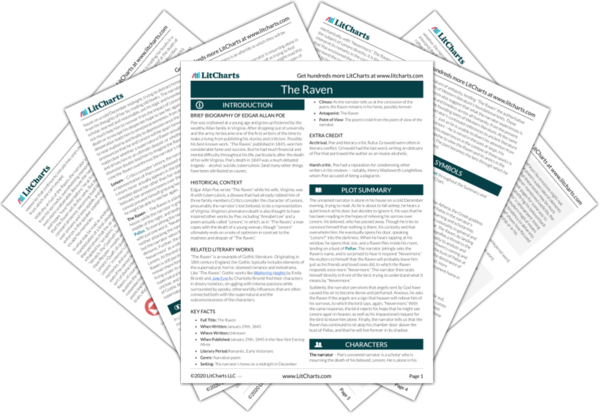Throughout the poem, Poe makes repeated references to classical mythology and the Bible — “ancient lore” such as what the narrator might have been studying at the beginning of the text. “Pallas,” the bust on which the Raven perches, is a reference to “Pallas Athena,” the Greek goddess of wisdom. Like Pallas Athena, the Raven hails from “the saintly days of yore.” The bird’s choice of landing place illustrates its relationship to ancient, divine, omniscient authority, solidifying a connection that the speaker makes explicit when he dubs the bird a “Prophet.” Further, “Nepenthe” is described in Homer’s Odyssey as a drug that erases memories, while the “Plutonian shores” are a reference to the god Pluto, the Roman equivalent of Hades in Greek mythology, who reigns over the underworld. The mention of “Gilead” refers to the Old Testament line in Jeremiah 8:22: “Is there no balm in Gilead? Is there no physician there?” and “Aidenn” refers to the Garden of Eden.
While these references help to establish the narrator as a scholar, they also allow Poe to anchor his poem to the classic literature of antiquity, lending “The Raven” the authoritative weight of Western literature’s foundational texts. These references also suggest that what the narrator experiences is universal and timeless across all humanity, from the present back to the founding texts of Western literature. At the same time, the narrator’s continued references to ancient literature suggest that — just as he is unable to divert his attention from his past with Lenore —he is mired in the past at large. His impulse to view his experiences in the context of these works is echoed by his impulse to view the Raven and its antics in the context of Lenore. The past becomes the lens through which he perceives the present.
Ancient Influences ThemeTracker

Ancient Influences Quotes in The Raven
Over many a quaint and curious volume of forgotten lore…

Unlock explanations and citation info for this and every other The Raven quote.
Plus so much more...
Get LitCharts A+Tell me what thy lordly name is on the Night’s Plutonian shore!
“Quaff, oh quaff this kind nepenthe and forget this lost Lenore!”
“Is there—is there balm in Gilead?”
And the Raven, never flitting, still is sitting, still is sitting
On the pallid bust of Pallas just above my chamber door…
And my soul from out that shadow that lies floating on the floor
Shall be lifted—nevermore!











